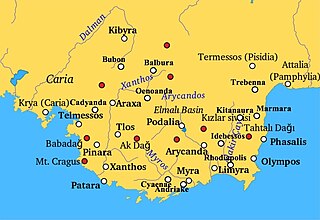
The dibbler is an endangered species of marsupial. It is an inhabitant of the southwest mainland of Western Australia and some offshore islands. It is a member of the order Dasyuromorphia, and the only member of the genus Parantechinus. The dibbler is a small, nocturnal carnivore with speckled fur that is white around the eyes.

Parthenos sylvia, the clipper, is a species of nymphalid butterfly found in south and southeast Asia, mostly in forested areas. The clipper is a fast-flying butterfly and has a habit of flying with its wings flapping stiffly between the horizontal position and a few degrees below the horizontal. It may glide between spurts of flapping.

Araxa was a city of ancient Lycia, according to Alexander Polyhistor, in the second book of his Lyciaca. Ptolemy places it near Sidyma. It is located at a place called Ören, near Fethiye, on the upper portion of the Xanthus River.
Sidyma, was a town of ancient Lycia, at what is now the small village of Dudurga Asari in Muğla Province, Turkey. It lies on the southern slope of Mount Cragus, to the north-west of the mouth of the Xanthus.

Brunia is a genus of tiger moths in the family Erebidae. The genus was erected by Frederic Moore in 1878.
Sidyma is a genus of moths in the subfamily Arctiinae. The genus was erected by Francis Walker in 1856.

Amyna is a genus of moths of the family Noctuidae erected by Achille Guenée in 1852.

Dindicodes is a genus of moths in the family Geometridae.

Conognatha is a genus of beetles in the family Buprestidae, tribe Stigmoderini, containing the following species: They are found in the Neotropical realm.

Notonomus is a genus of ground beetles in the family Carabidae. There are more than 120 described species in Notonomus, found in Australia.

Pogonus is a genus of ground beetles in the family Carabidae, found worldwide. There are more than 50 described species in Pogonus.

Dindicodes apicalis is a moth of the family Geometridae first described by Frederic Moore in 1888. It is found in Asia, including India and China.

Neodrymonia apicalis is a moth of the family Notodontidae first described by Frederic Moore in 1879.

Sidymella is a genus of spider in the family Thomisidae, found in South America, Australia and New Zealand. It was originally named Sidyma, but this was later found to have been used already for a genus of moths.
Temnosternus apicalis is a species of beetle in the family Cerambycidae. It was described by Francis Polkinghorne Pascoe in 1878. It is known from Australia.
Kalabantia or Kalabatia (Καλαβατία) was a town of ancient Lycia, which per the Stadiasmus Patarensis was 24 stadia by road from Sidyma.










